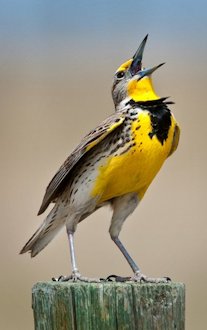
|
Bird Ranges and Barriers - Page 2 A forest can effectively block the spread of a grassland bird like the Horned Lark, and grasslands can become an effective barrier to many forest birds. The ranges of species fluctuate in response to changes in the limiting effects of barriers. Large areas of the eastern deciduous forest that farmers cleared for crops and livestock have created habitat for the Eastern Meadowlark, Brown-headed Cowbird, and the Horned Lark; these species have been able to expand their ranges eastward. Ranges also change with each passing season. For example, many birds migrate to more favorable climates for the winter. We call the portion of a migratory bird's range in which it nests and raises its young, the breeding range; we call the area in which it spends with winter, the winter range. Bird-watchers refer to a bird as a transient if the see it in an area through which it normally passes on migration. If a bird wanders outside of its normal range, we call it a vagrant. We call nonmigratory birds permanent residents. |
| Eastern Meadowlark |